Imagine yourself in a Harry Potter story, visiting Eeylops Owl Emporium. Which owl would you choose? A screeching Common Barn Owl Tyto alba, perhaps a rare Turkish Fish Owl Bubo semenowi or the one Hagrid chose for Harry, a huge Snowy Owl Bubo scandiacus? For Mark it would have to be a Long-eared Owl Asio otus.
It’s easy to become obsessed with Long-eared Owls. For a start they are stealthy. They live longer that way. Often they hide right under our muggle noses. Camouflaged against bark and twigs, dozens hide themselves in urban parks, then glide out incognito into the darkness. When winter ends they find new ways to escape our attention. The simple, repeated hoot of a male Long-eared Owl could hardly be subtler (CD2-57). Once noticed, its deep smoothness is to be savoured. Without traffic, planes or wind to drown it out, it can travel half a kilometre or more. Usually, however, nobody will notice.
CD2-57: Long-eared Owl Asio otus otus Pancas, Benavente, Portugal, 23:25, 28 February 2013. Hooting of a male in open Holm Oak Quercus ilex woodland, with large pools here and there following heavy rain. Background: Mallard Anas platyrhynchos and Tawny Owl Strix aluco. 130228.MR.232502.01
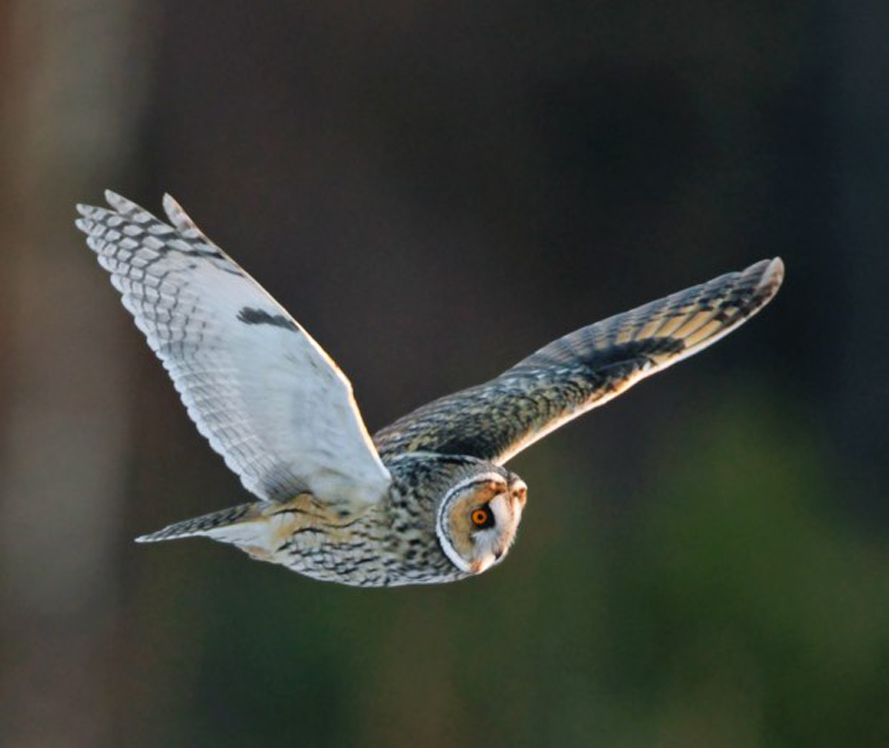
Long-eared Owl Asio otus, Hanko, Uusimaa, Finland, 14 March 2012 (Dick Forsman)
Among all the recordings in this book it is this next one from Portugal that makes Mark jealous. Despite huge efforts, he has never managed to make a good recording of a Long-eared Owl. The male in CD2-58 is the same as in CD2-57, but now he is at the centre of a much livelier scene. Amazingly, his neighbour sounds almost as loud despite being 30 times more distant.
CD2-58: Long-eared Owl Asio otus otus Pancas, Benavente, Portugal, 00:46, 20 February 2013. Hooting of two males. At 0:28 a female joins in with her Vvvw call, the loudest sound in the recording. Background: besides the munching of a herd of young bulls there are several Tawny Owls Strix aluco, flight calls of a gradually approaching Water Rail Rallus aquaticus (from 0:10), and a loud Southern Tree Frog Hyla meridionalis (from 0:11). 130220.MR.004658.31
Achieving such projection is all about choosing the right songpost. The trick is to take advantage of interference between direct and reflected sound waves (Catchpole & Slater 2008). Sit at the wrong elevation and the wave bouncing off the ground will be half a wavelength out of phase with the one travelling directly to the listener: they will cancel each other out, causing attenuation of the sound. Choose the right elevation and the two different waves will differ by one wavelength: they will sum with each other. The sound will be intensified and carry further. As CD2-58 unfolds, we hear several Tawny Owls Strix aluco, the gradual approach of a migrating Water Rail Rallus aquaticus (from 0:10), a loud Southern Tree Frog Hyla meridionalis (from 0:11) and the grazing of a herd of young bulls. Then at 0:28 a female Long-eared Owl joins in with her Vvvw call, the loudest sound in the recording.
Occasionally, individual males depart from their usual smooth timbre and produce slightly strained-sounding hoots. One that I recorded in 2012 consistently hooted with a harsher timbre. Otherwise, his behaviour was very typical. In CD2-59, he takes off after 29 hoots, giving a series of single wingclaps while flying a circuit around the nesting area. At 1:25 his mate gives several loud Vvvw calls, then flies right with almost identical wingclaps. Long-eared Owls clap underneath the body, never above it (Scott 1997). Males clap much more often than females, often while flying from a songpost to join their mate. Unpaired males hoot, but they do not clap (Hawley 1966).
CD2-59: Long-eared Owl Asio otus otus Pancas, Benavente, Portugal, 04:52, 16 April 2012. Unusually harsh hooting of a male, then wingclaps. From 1:25 Vvvw calls of female, then her wingclaps. Background: European Tree Frog Hyla arborea, Little Owl Athene vidalii, Tawny Owl Strix aluco and Common Nightingale Luscinia megarhynchos. 120416.MR.045255.11
The female’s Vvvw is a soliciting call and her most characteristic sound during the breeding season. It is much more nasal and higher-pitched than male hooting, and usually repeated at intervals of 5 seconds or more. The interval between male hoots is rarely more than 3.3 seconds. Shaped like a heavy sigh, the Vvvw descends and fades out towards the end. If you have ever tried the old game of humming through a comb covered in cigarette paper (or Izal, that crispy and perhaps obsolete toilet paper that scratches your backside), well, the timbre is a lot like that. CD2-60 has smooth-sounding, humming Vvvw calls that could be confused with male hooting were it not for the very long gaps. CD2-61 is a slightly richer-sounding individual, one that already featured in CD2-59. Finally, CD2-62 is a rather harsh-sounding female at very close range.
CD2-60: Long-eared Owl Asio otus otus Kennemerduinen, Bloemendaal, Netherlands, 23:25, 2 June 2012. Vvvw calls of a female, smooth variant. Background: Common Nightingale Luscinia megarhynchos. 120602.AB.232530.01
CD2-61: Long-eared Owl Asio otus otus Pancas, Benavente, Portugal, 00:06, 7 April 2012. Vvvw calls of a female, typical variant. Background: Tawny Owl Strix aluco and Common Nightingale Luscinia megarhynchos. 120407.MR.000616.01
CD2-62: Long-eared Owl Asio otus otus Pancas, Benavente, Portugal, 00:17, 1 March 2013. Vvvw calls of a female, harsh variant. Background: Tawny Owl Strix aluco. 130301. MR.001748.02
A rich texture of harmonics makes Vvvw calls seem louder than male hoots at close range, but from a couple of 100 m they are barely audible. This is because the harmonics decay so rapidly with increasing distance. From the courtship period until sometime after the young hatch, the female calls frequently from the nest, usually one built by corvids or raptors, or from elsewhere in the same tree. For this reason the Vvvw is sometimes called the ‘nest call’. Before selecting one, she may Vvvw from anywhere in the wood (Hawley 1966).

Approximate breeding distribution of Long-eared Owl Asio otus in pink Recording locations of Long-eared and Wilson’s Owl A wilsonianus (in North America) indicated by red dots.
Across the whole of Eurasia, only one population is distinct enough to merit separation as a subspecies, being smaller and more heavily marked, with reddish eyes. Canarian Long-eared Owl A o canariensis is fairly common on well-wooded islands such as Gran Canaria and Tenerife, but has only recently been found breeding on Fuerteventura (López-Darias et al 2006).
By searching one of the few pine forests on that island, René Pop and I found a winter roost holding at least four. About 40 African Northern Ravens Corvus corax tingitanus arrived to spend the night there just when the owls were leaving. As the sky darkened, the cacophony gradually died down. From within the owl roost, we heard some familiar-sounding wingclaps. Then not far away, a male started to hoot. A week later we returned, better prepared. I left my equipment recording in a clump of pines, more or less where I thought the male had been. Fortunately, he chose the same songpost and hooted bravely among the ravens (CD2-63).
CD2-63: Canarian Long-eared Owl Asio otus canariensis Betancuria, Fuerteventura, Canary Islands, 18:54, 29 January 2010. Male hooting in the middle of an African Northern Raven Corvus corax tingitanus roost. 100129.MR.185427.01
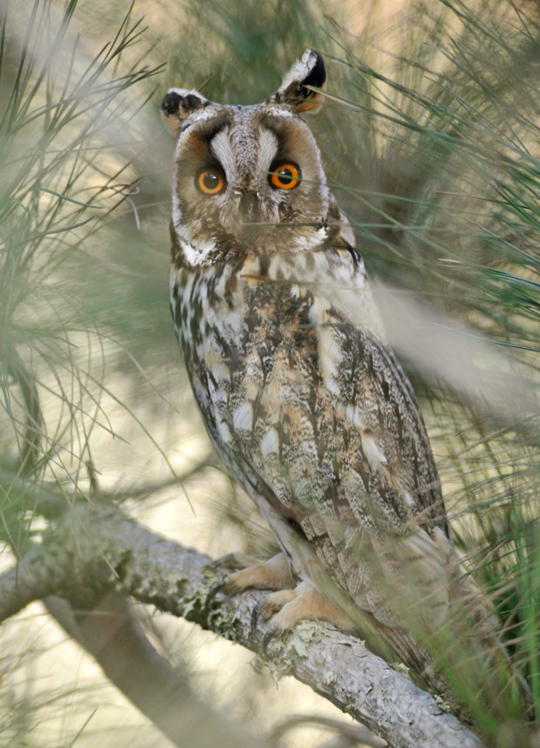
Canarian Long-eared Owl Asio otus canariensis, Betancuria, Fuerteventura, Canary Islands, 22 January 2010 (René Pop). Bird from the same tiny roost as the male in CD6-63.
Given that they are around 10% smaller (Cramp 1985), it seems surprising that neither this male nor another recorded by Moreno (2000) sounded different from their relatives on the mainland. Perhaps canariensis only evolved very recently. Genetic studies show no clear distinction from continental otus (Wink et al 2008). Long-eared have also colonised the Azores, but without evolving a distinctive appearance at all (Bannerman & Bannerman 1966).
The long-eared owl that occurs in North America – let’s call it Wilson’s Owl Asio wilsonianus – has been evolving separately for much longer. Its mtDNA differs from that of its Palearctic relatives by 1.13% (Johnsen et al 2010), suggesting around half a million years of isolation. Wilson’s has two subspecies: wilsonianus in the east and tuftsi in the west. Both share yellow irides, a more golden-rufous facial disk outlined by a blacker ruff, and much heavier cross-barring on the underparts than Long-eared Owl. Hooting of Wilson’s averages higher-pitched (CD2-64), as I discovered by comparing 10 individuals from widely spread locations on each continent.
CD2-64: Wilson’s Owl Asio wilsonianus tuftsi Walla Walla county, Washington, USA, 20:30, 20 April 1990. Hooting of a male. David S Herr and The Macaulay Library at the Cornell Lab of Ornithology.
Female Long-eared Owls occasionally hoot, and when they do, their pitch is higher than that of males. So beware of claiming a Wilson’s Owl in Europe! In CD2-65, the context was rather unusual, involving two females and a male. An intruding female had the audacity to give Vvvw calls in flight close to a nesting tree while another female was in it. The latter had then reacted by flying a little circuit, wing-clapping and giving a very rapid series of hoots, before landing back in her nest and rustling it noisily. Over the course of 25 minutes she switched several times between Vvvw calls and a high-pitched form of hooting with long notes. I interpreted her hoots as aggression towards the second female while the Vvvw calls were directed at the male. He, meanwhile, spent much of the time hooting normally some distance away.
CD2-65: Long-eared Owl Asio otus otus Pancas, Benavente, Portugal, 00:16, 1 March 2013. Hooting of a female and a more distant male. From 2:04, female Vvvw calls. Background: Red Fox Vulpes vulpes, Mallard Anas platyrhynchos, Common Barn Owl Tyto alba and Tawny Owl Strix aluco. 130301.MR.001644.02
The ‘nest-showing call’ (Mebs & Scherzinger 2004) is a speeded-up version of hooting. Again females are higher-pitched than males. In CD2-66, a male and female are flying around a small clump of pines during an early stage of courtship. Both are using the nest-showing call and both are wing-clapping, especially the male. At 0:08 they appear to land briefly, then at 0:24 the female gives a loud Vvvw call as the male flies off.
CD2-66: Long-eared Owl Asio otus otus Pancas, Benavente, Portugal, 01:01, 7 April 2012. Nest-showing calls and wing-clapping of a male and a female. Background: Mallard Anas platyrhynchos and Common Nightingale Luscinia megarhynhos. 120407.MR.010155.01
Wingclaps of Long-eared Owls come in two variants: single and double. The latter are doubled so quickly that this seems to have escaped anyone’s attention so far. A single bird produces both claps: these are not duets. Exactly how the double clap is produced is still a mystery. In CD2-67 the first few claps are single, then from 0:09 there follows a series of double claps. Towards the end of the recording there are some faint, high-pitched calls accompanied by bill-snaps. These fit sketchy descriptions of copulation calls in the literature (eg, Scott 1997), but I could not confirm what happened. I only know that the male and female were in close physical proximity when I heard those calls.
CD2-67: Long-eared Owl Asio otus otus Kennemerduinen, Bloemendaal, Netherlands, 19:22, 6 April 2008. Wingclaps of male – single then double – followed by high-pitched calls and bill-snaps, indicating close contact or possibly copulation. 080406.MR.192202.02
In southeast Dorset where Mark lives, Long-eared Owls are rare. Reading an article in the Norfolk Bird Report (Kemp 1981), he became inspired to search for calling young. Over two summers and twenty-plus nights he found… none! More often, juveniles are the only clue that finally gives a breeding attempt away. Their piercing, eerie begging calls carry far. Usually, they only become conspicuous during the last of three weeks that the young are in the nest. The youngest owlet calls more often and at a higher pitch than its larger siblings. In CD2-68, the pitch difference between the two fledglings is obvious. Between them, the young may keep a stream of these loud calls going virtually all night long until they are 7 or 8 weeks old. Some may even beg until 14 or 15 weeks of age, long after they are able to catch prey for themselves (Scott 1997). I often wonder how they can afford to make themselves so conspicuous.
CD2-68: Long-eared Owl Asio otus otus Rosmaninhal, Idanha-a-Nova, Portugal, 01:22, 15 May 2012. Begging calls of two fledglings. In this case the younger, higher- pitched fledgling calls only slightly more often than its older sibling. Background: Woodlark Lullula arborea and Common Nightingale Luscinia megarhynchos. 120514.MR.012236.01
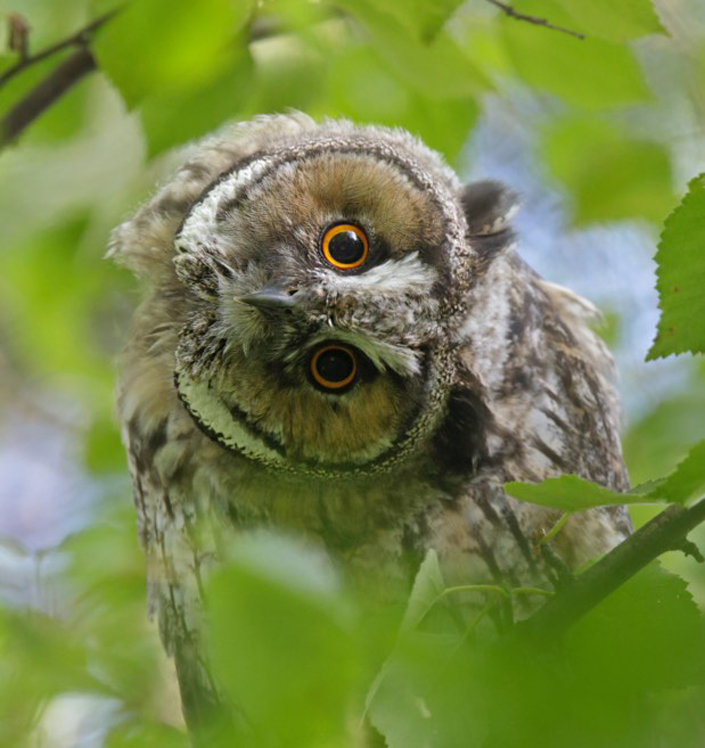
Long-eared Owl Asio otus, juvenile, Helsinki, Uusimaa, Finland, 10 July 2014 (Dick Forsman)
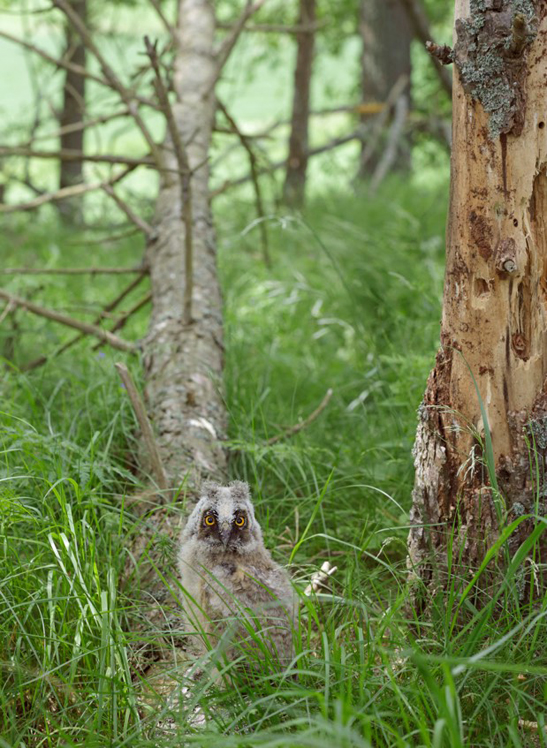
Long-eared Owl Asio otus, fledgling, Kirkkonummi, Uusimaa, Finland, 10 June 2014 (Dick Forsman). Bird perhaps fledged the day before.
If you approach a brood of Long-eared Owls, sooner or later you will probably hear some gruff, rising barks, most likely in threes or fours. Since the juveniles ignore them and carry on begging, Wendland (1957) concluded that barking calls do not warn about danger but express irritation. Females also bark, for example, if a male takes too long to bring food to the nest (Cramp 1985). Males occasionally bark too (eg, Saurola 1995).
The four young in CD2-69 are all within 15 m of one another. The female barks frequently, probably because of me, while two of the juveniles beg nearby. When the male arrives with prey she gives some very harsh Vvvw calls. The male leaves almost immediately, giving a series of quickly repeated coarse hoots known as ‘departure calls’. The female then takes off after him, perhaps because he failed to deliver prey.
CD2-69: Long-eared Owl Asio otus otus De Weerribben, Overijssel, Netherlands, 22:00, 3 June 2005. Juvenile begging calls and adult female barking. From 0:38, female Vvvw calls and from 0:46, departure calls of male. Background: Common Cuckoo Cuculus canorus, Common Blackbirds Turdus merula and Bluethroat Luscinia svecica. 05.014. MR.10048.11
Juveniles also have barking calls, although these lack any hint of gruffness and are as high-pitched as their begging calls (CD2- 70). The rhythmic pattern is very similar in juveniles and adults.
CD2-70: Long-eared Owl Asio otus otus Kolarovo biological station, Tomsk, Russia, 03:10, 6 July 2011. Juvenile barking and begging calls. Background: Siberian Rubythroat Calliope calliope. 110706.AB.031002.31
By this late stage in the breeding cycle, the female no longer repeats her Vvvw call in long, song-like sequences. Instead, she uses a harsh version briefly when the male arrives with prey, and sometimes also when feeding the young (Mebs & Scherzinger 2004). The male has his own version, which he uses most often at this time. If anything, his is coarser, deeper and harder sounding, and certainly never a hum. He often announces himself with a Vvvw just before delivering prey, often forming a duet with the female. In CD2-71, a male and female are both using harsh Vvvw calls, with the female more prominent than the male.
CD2-71: Long-eared Owl Asio otus otus De Weerribben, Overijssel, Netherlands, 22:00, 3 June 2005. Vvvw of female and begging calls of fledglings. Male visits briefly at the start, giving ‘departure calls’ as he moves off to the right, followed by a series of distant Vvvw calls. At around 0:45 he returns to deliver prey, giving a brief Vvvw at close range followed by ‘departure calls’ and one last Vvvw after returning to the right. Background: Northern Lapwing Vanellus vanellus, Eurasian Curlew Numenius arquata, Common Snipe Gallinago gallinago and Bluethroat Luscinia svecica. 05.014. MR.10400.01
Once Killian and I found a brood of Long-eared Owls in eastern Portugal. As we approached them the two fledglings, which were barely able to fly, stopped calling and hid inside a bush. At this point I was distracted by chaotic flapping sounds and screams about 20 m away. It sounded as some unfortunate creature was fighting for its life. Then I understood. An adult was trying to distract me away from the young. When it happened again I made a brief recording (CD2-72). The fledglings remained silent. When I moved away from the bush, both adults started giving harsh Vvvw calls from some tall pines nearby (CD2-73).
CD1-72: Long-eared Owl Asio otus otus Rosmaninhal, Idanha-a-Nova, Portugal, 21:40, 30 May 2011. Distraction display of an adult. 110530.MR.214032.13
CD2-73: Long-eared Owl Asio otus otus Rosmaninhal, Idanha-a-Nova, Portugal, 21:47, 30 May 2011. Vvvw calls of adult male and female. Background: Iberian Green Frog Pelophylax perezi. 110530.MR.214700.02
It is always a treat to actually see a Long-eared Owl. Sometimes, we flush one by accident. Other times, we might sense a pair of eyes watching us after following a Yellow-browed Warbler Phylloscopus inornatus deep into a thicket. Arnoud sometimes catches them while ringing migrants, especially in August-November. He caught the adult female in CD2-74 at his regular site. Its bill-snaps and hisses are universal owl language, used to issue threats at close quarters when escape is not possible.
CD2-74: Long-eared Owl Asio otus otus Van Lennep ringing station, Bloemendaal, Noord-Holland, Netherlands, 10:32, 13 October 2011. Hissing and bill-snapping of an adult female in the hand. 111013.AB.103211.11
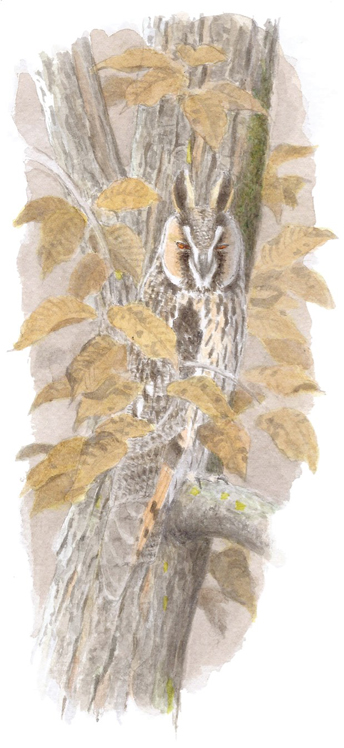
Håkan Delin
Autumn hooting is rare, but I recorded it once in the Ebro Delta, Spain. Two individuals were hooting in the same small area, close to where Ricard Gutiérrez told me there had been a nest in the spring. One of them sounded like a typical male, but the other sounded very strange. It gave hoots with the same rhythm as a male, but with a higher-pitched, hoarse voice reminiscent of soliciting calls (CD2-75). I presume that it was a female, although it sounded nothing like the one in CD1-65.
CD2-75: Long-eared Owl Asio otus otus L’Eucalyptus, Catalonia, Spain, 00:59, 28 September 2014. Hoarse hooting of a presumed female in autumn. Background: migrating European Robin Erithacus rubecula. 140928.MR.005940.11
Long-eared Owls are famous for roosting communally during the winter, sometimes on a spectacular scale. In Kikinda, Serbia, the town square hosts up to 750 in a single roost. In the Netherlands, many roost in urban areas but in more moderate numbers. Arnoud always shows them on his five-day Limosa Holidays winter birding tours. During a scouting trip in February 2008, he visited a roost just 2 km from Schiphol airport. At dusk, the owls gave faint calls as they prepared to go hunting (CD2-76). These were unfamiliar to both of us at the time, but now I realise they have a rhythm similar to barking calls. Recorded from just 5 m, they were very quiet indeed.
CD2-76: Long-eared Owl Asio otus otus Vijfhuizen, Noord-Holland, Netherlands, 18:14, 19 February 2008. Very quiet barking calls before leaving roost. Background: Common Blackbird Turdus merula. 080219.AB.181427.32
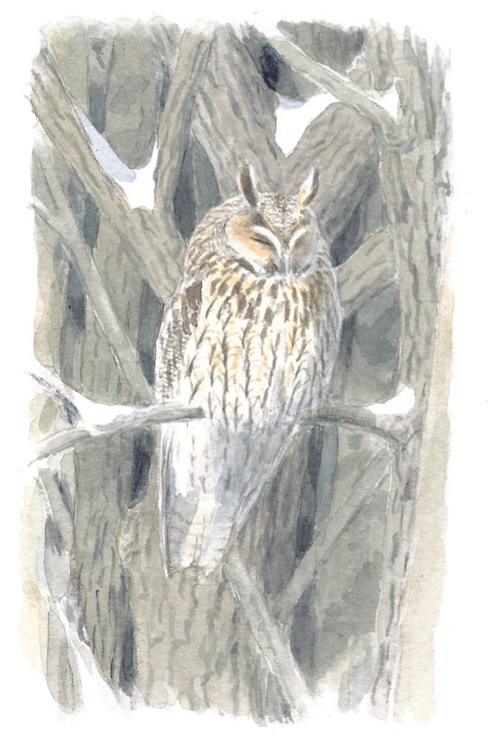
Håkan Delin
Long-eared Owls’ excellent hearing allows them to hunt voles and other small mammals in near total darkness (Payne & Drury 1958). One might imagine that their extra long ‘ear tufts’ enhance their hearing. In fact these pinna are not receivers of any kind, but transmitters. Like other head ornaments, which include bright orange irides, white ‘eyebrows’ and ‘chinstrap’, and blackish ‘harlequin’s tears’ above and below the eyes – they can be activated by raising or flattening different feather tracts. Such ornaments communicate mood, but only if they can be seen. Galeotti & Rubolini (2007) showed that species with more ornaments tend to hunt more by daylight and live in more open habitats. Only the latter applies to Long-eared Owls.
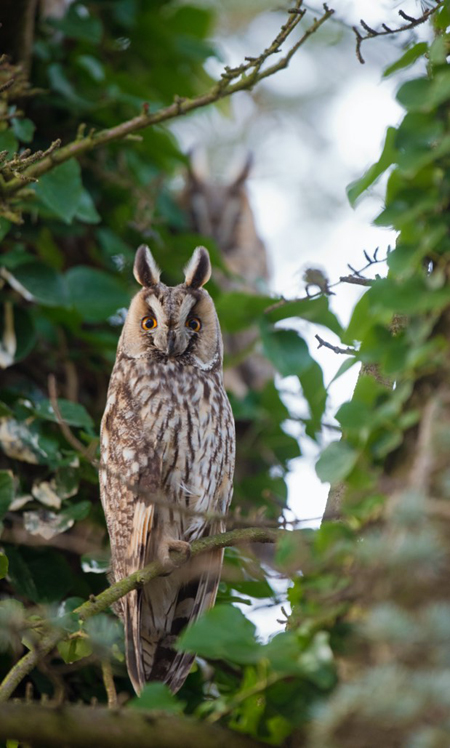
Long-eared Owl Asio otus, two at winter roost of c 10, Swifterbant, Flevoland, Netherlands, 7 February 2014 (Arnoud B van den Berg). Similar situation as in CD2-76.
Unlike Common Barn Owls or Short-eared Owls A flammeus, Long-eared Owls rarely call in flight, except in the Netherlands where they give a trumpeting nasal honk-honk or a staccato kip-kip-kip as they fly past at night…. Curiously, this kip-kip-kip is the same flight call that Common Barn used to give, but only in Britain. Different birding cultures have their own traditions, and sometimes they perpetuate errors. The nasal honk-honk is in fact a Eurasian Coot Fulica atra flight call and the kip-kip-kip belongs to Common Moorhen Gallinula chloropus (Constantine et al 2012). The British barn owl tradition was politely deconstructed by Bunn et al (1982), while de Wijs (2009) whacked the Dutch Long-eared Owl fallacy hard on the head.
Nocturnal flight calls of other marshland birds somehow never became part of these traditions. How many observers would recognise a Little Grebe Tachybaptus ruficollis if it flew overhead in spring? Or a Short-eared Owl, chasing a rival away from vole-rich mire on a late autumn night?

